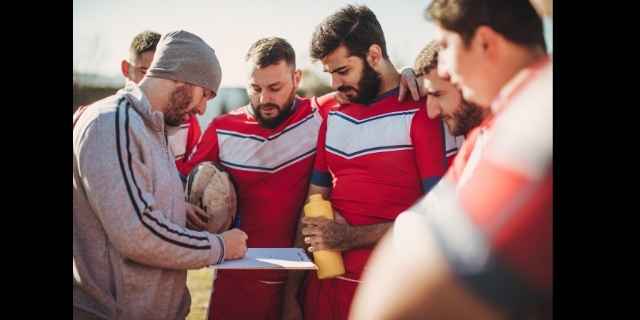A grubber kick in rugby league is a low, rolling kick that bounces unpredictably along the ground.
It is often used to create try-scoring opportunities by bouncing the ball into the in-goal area.
In this article, I’ll look at when it’s used, what attackers should do, and how defenders try to defend the grubber.
The Grubber As A Last Tackle Option
You will most likely see a grubber in rugby league during the last tackle play when close to the opposition try line.
The best outcome for the kicking team is a try-scoring opportunity in the in-goal area.
If the attacking players chase the kick effectively, they either get to the ball first or force the defender into making a mistake.
If a defending player is forced to ground the ball in the in-goal area or knock it dead, the attacking team will earn a goal-line dropout.
This gives the attacking team another set of six tackles, allowing them to maintain pressure on the opposition.
What Teammates Do After A Grubber Kick
When a player kicks a grubber into the in-goal area in rugby league, attacking players need to act quickly.
They seek to maximize their chances of scoring a try or applying pressure on the defending team.
They must immediately start chasing the grubber kick as it heads towards the in-goal area.
Their goal is to reach the ball before the defenders.
Their best outcome is to score a try by grounding the ball. The next best outcome is to force the defenders to make a mistake.

Applying pressure
While chasing the grubber kick, attacking players should apply pressure on the defending players attempting to secure the ball.
This pressure may force the defenders to make an error, such as knocking the ball on or carrying it over their own dead-ball line.
This can result in a try or a repeat set of tackles for the attacking team.
Supporting grubbers
Attacking players who won’t arrive first to the ball should be ready to support the teammates ahead of them.
If the teammate who first reaches the ball is unable to ground it or is tackled, other attacking players should be in position to pick up the ball or receive a pass to continue the attack.
Reading the bounce
Grubber kicks can have unpredictable bounces.
This means that attacking players need to be prepared to react quickly and adjust their positioning to capitalize on any favorable bounces or deflections.
Keeping onside
Attacking players must be behind the kicker when the grubber kick is made to avoid being offside.
If an attacking player is offside and involved in the play, a penalty will be awarded to the defending team.
How To Defend Grubber Kicks In The In-Goal Area

Fullbacks and wingers should be aware of the potential for a grubber kick and adjust their positioning accordingly.
They should not stand too deep in the in-goal area, as this would give the attacking players more time to chase the kick and put pressure on the defenders.
When a grubber kick is executed, defenders keep their eyes on the ball and track its movement along the ground.
This helps them judge the bounce and trajectory of the ball, making it easier to predict where it will end up and when they need to make a play on it.
Securing the ball
The defenders job in the in-goal area is to secure the ball and prevent the attacking players from scoring.
Defenders can either:
- catch the ball on the full
- dive on it to smother the ball
- use their feet to control the ball and kick it dead or into touch
In some cases, defenders may also opt to bat the ball dead to force a goal-line dropout. This concedes possession but prevents a try.
What do defenders do if they secure possession in the in-goal area?
Defenders should quickly assess the situation and decide whether to:
- run the ball out of the in-goal area
- kick it dead
- ground it for a goal-line dropout
This decision depends on factors such as the position and pressure of the attacking players.
It also depends on the defender’s confidence in their ability to escape the in-goal area without conceding a try.
How Grubber Kicks Are Executed
The kicker holds the ball in both hands, with the pointy end facing downwards at a slight angle towards the ground.
This angle helps create the desired end-over-end rolling motion when the ball is kicked.
Before the strike
The player is often running sideways across the defensive line, lining up with the target area on the field. They keep their eyes on the target and the defensive line to identify a gap in the opposition’s defense.
As the player gets closer to the point where they want to kick the ball, they release it and let it drop to the ground.
It is crucial to time the drop correctly so that the ball is in the ideal position for contact with the foot.
Strike and follow through

Players strike the ball with the inside of the foot, which allows for better control and accuracy.
The objective is to create a low, rolling kick that bounces and moves unpredictably along the ground.
After making contact with the ball, the kicking leg continues forward. This is known as following through in the direction of the target area.
This will help maintain accuracy and control over the trajectory and speed of the kick.
More About Kicking
Grubber kicks are aimed downward to scud along the ground. In contrast, high kicks and bombs in league are aimed with a high trajectory.
The 40/20 kick is also high but is aimed to bounce before crossing the side line. Cross-field kicks in league tend to be long and lateral but not as high as a bomb.
Check out our article on kicking in rugby league for a rundown of all the types of kicks in the sport.